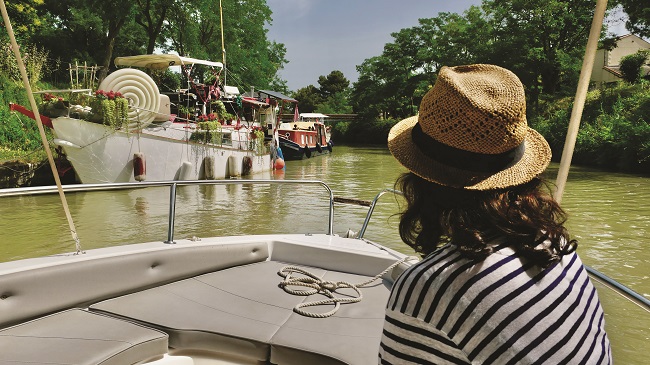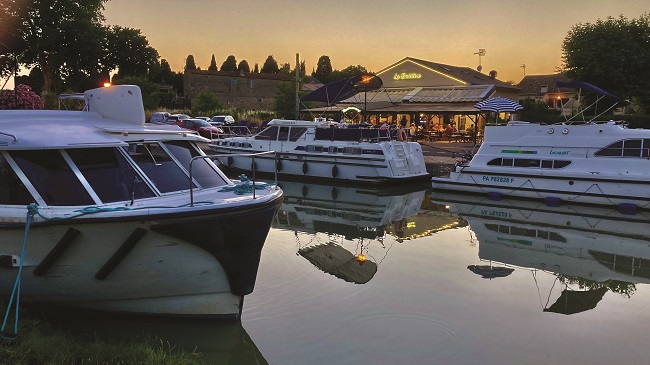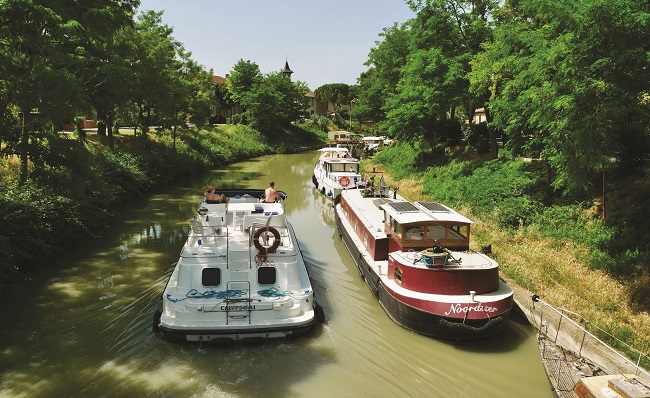Taking it Slow Along the Canal du Midi

Unveil the delights of the Canal du Midi, in the south of France, by exploring by boat, bicycle and on foot.
As anyone who has done a boat trip here will tell you, gliding through the eerily dark Tunnel de Malpas is great fun. But to really experience this emblematic site on the Canal du Midi, a few miles west of Béziers, it’s best to walk along the towpath inside the tunnel with a professional guide. Like this, you can step back in time and learn the remarkable story of how it was built, as well as what makes it so special.
As our guide, Maïté Gérard, explains, the 165m-long construction, which dates from 1680, is not only an extraordinary feat of engineering, but the first navigable canal tunnel in the world. Et voilà! The UK may be proud of its canal-building prowess, but the French got there first. More specifically, it was Béziers-born Pierre-Paul Riquet who masterminded the project, solving a specific set of problems in situ. As we also learn, the tunnel is the only one on the canal. But the most surprising fact about it is that it was dug in little more than a week – much to the chagrin of the sceptics, who numbered amongst them the then finance minister, Jean-Baptiste Colbert. But back to that story in a moment.

The Tunnel de Malpas © Steve Turnbull
The next stop on our trip is a short walk up the hill overlooking the tunnel. At the top, we discover the Oppidum d’Ensérune (‘oppidum’ means fortified town or settlement in Latin). Listed as an historical monument since 1935, this is widely regarded as one of the most important Gallo-Roman sites in the south of France. The newly refurbished museum certainly holds an impressive collection of artefacts, illustrating the range of civilisations, Celtic and Iberian included, that left their mark here. It also puts the site, which dates from the 7th century BC to the 1st century AD, into a very clear historical context with the aid of models and state-of-the-art multimedia technology.
What’s more, the museum tells the fascinating story of the Oppidum’s excavation by archaeologists following its discovery by Abbot Giniès in 1860. But perhaps the most interesting aspect of the site is its necropolis (burial ground) where the remains of hundreds of its former inhabitants have been unearthed. Several of these have been ‘brought back to life’ so convincingly inside the museum that the effect is really quite moving.
Read More: A Voyage through Time on the Canal du Midi

The extraordinary Étang de Montady © Steve Turnbull
But that’s not all the site has to offer. It also overlooks the Étang de Montady which is quite unlike anything we’ve seen in the south of France or anywhere else – from high up it looks like a giant dartboard. In fact, this dried lake (étang) was developed in the middle ages as a drainage system to increase arable land, improve irrigation, and combat insect infestation. Amazingly, the tunnel that channels the water is still in use today. Later, via more information at the Maison de Malpas visitor centre, located right next to the canal tunnel, we begin to piece together a detailed picture of the area. In effect, it’s an historical crossroads where antiquity and modernity meet: in addition to the other tunnels, the Via Domitia Roman road, which traverses the area, is the oldest in France, and there’s a railway tunnel connecting Bordeaux and Sète. We also learn that Malpas means ‘bad crossing’, but there’s nothing negative about what we’ve seen so far. On the contrary, the beautiful Hérault scenery, which has more than a hint of Provence or Tuscany about it, has been every bit as delightful as the historical sights.
The next day we take a short drive further west to Capestang. This village is best known as a pretty port on the canal, but its centre is equally charming and offers plenty more of interest. At the 14th-century Collégiale Saint-Étienne, which overlooks the market square, we meet up with Dominique Saillard for a guided tour. This begins very interestingly with an introduction to the church’s history, then proceeds to our favourite part, the bell tower (clocher). In a ‘secret room’ half way up, Dominique shows us a chess board carved into the stone floor that was used by soldiers, and at the top we enjoy wonderfully panoramic views extending across the coastal plain and all the way to the Pyrenees.

The port area at Capestang © Steve Turnbull
Medieval magic
Next stop is the Château des Archevêques de Narbonne (the summer residence of the archbishops of Narbonne) just a stone’s throw away. Here, in the great hall, Dominique shines his torch on the beams in the timbered ceiling, revealing some remarkable medieval paintings. Even more remarkable, given that these days practically everything in museums is protected behind glass, the paintings are “en plein air”. Nonetheless, they remain very well preserved, enabling us to appreciate how ornate, richly coloured and highly symbolic they are. The experience is quite magical, all the more so because the identity of the painter(s) from all those centuries ago remains a mystery.
Later, we enjoy a tour and very tasty Mediterranean-style lunch at the recently opened micro-brewery, Brasserie Oppidum, in Capestang. The area may be best known for wine, but if you could bottle the passion this place has for craft beer you could open a whole chain of breweries. Bravo also to two excellent restaurants we enjoyed locally – Le Vauban in the heart of the village, and L’Auberge de la Croisade just beyond at Cruzy, with its attractive canalside setting.

Picturesque Poilhes © Steve Turnbull
The next morning we drive back in the direction of Béziers to another pretty port, Colombiers, for a boat trip. After a technical briefing on our seven-seater from one of the proprietors at Sunboat (the company offers a licence-free selection of boats) we’re soon chugging along the canal. Soon we approach the Tunnel de Malpas and give an obligatory toot on the horn in case a larger craft is coming the other way. As it happens, we’re in the clear and emerge at the other end into more delightful scenery. We then turn around at Poilhes, yet another picturesque village on the canal that offers a choice of restaurants. Here, we tucked into one of the best veggie meals we’ve ever had in France – merci beaucoup, Les Platanes!
On our final day we head to the outskirts of Béziers. Forget what you may have heard about this city, it’s a very appealing as well as richly historical place that has had an extensive makeover in recent years. A must-visit is the Écluses de Fonseranes, a cascading lock system, also created by Riquet, that is truly awe-inspiring. More recently, the area has seen the development of an extensive network of cycle and walking paths, so we hire bikes and head down to the charming Maison Batelière (lock-keeper’s house) and back, taking in the Pont-Canal de l’Orb and Pont Vieux along the way.
Read More: Languedoc for Nature Lovers

Cycling along the canal at the Écluses de Fonseranes © Steve Turnbull
A feat of engineering
Finally, we enjoy one of our favourite experiences on the trip: the immersive cinema at the Écluses de Fonseranes visitor centre. Here, with headphones on for commentary, we are surrounded by the action as the story of this most impressive and arguably the most scenic section of the Canal du Midi unfolds. What comes across more than anything is what an epic undertaking the canal was for Riquet, helped by legions of labourers. It certainly wasn’t all plain sailing. To pick up the story about Colbert, he was convinced (with King Louis XIV breathing down his neck, no doubt) that the Tunnel de Malpas would collapse due to the hill’s crumbly subsoil. But, undaunted, Riquet had the sheer chutzpah to build it in secret using structural supports – tunnel vision, you might say. Sadly, the engineering genius died just eight months before the canal was completed. But his legacy lives on: today, his remarkable achievements are celebrated both locally and globally – the area was classified as a UNESCO World Heritage Site in 1996. It is also a Grand Site de France ‘en projet’ (aiming for full status in due course).
So, if you’re lucky enough to visit this corner of France be sure to take the time, slow tourism-style, to explore it to the full. As well as being exceedingly beautiful, it’s surprisingly rich in history and offers plenty to enjoy, both on and off the canal.
From France Today magazine
Lead photo credit : Boating along the canal at Poilhes © Steve Turnbull
Share to: Facebook Twitter LinkedIn Email
More in boating in France, canal du midi, slow travel, South of France
Leave a reply
Your email address will not be published. Required fields are marked *



